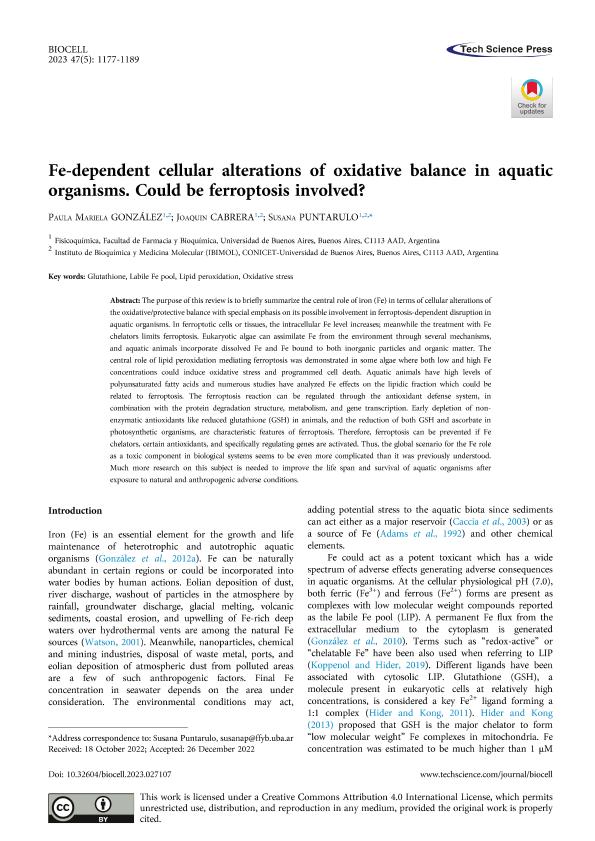Artículo
Fe dependent cellular alterations of oxidative balance in aquatic organisms. Could be ferroptosis involved?
Fecha de publicación:
04/2023
Editorial:
Instituto de Histología y Embriología
Revista:
Biocell
e-ISSN:
1667-5746
Idioma:
Inglés
Tipo de recurso:
Artículo publicado
Clasificación temática:
Resumen
The purpose of this review is to briefly summarize the central role of iron (Fe) in terms of cellular alterations of the oxidative/protective balance with special emphasis on its possible involvement in ferroptosis-dependent disruption in aquatic organisms. In ferroptotic cells or tissues, the intracellular Fe level increases; meanwhile the treatment with Fe chelators limits ferroptosis. Eukaryotic algae can assimilate Fe from the environment through several mechanisms, and aquatic animals incorporate dissolved Fe and Fe bound to both inorganic particles and organic matter. The central role of lipid peroxidation mediating ferroptosis was demonstrated in some algae where both low and high Fe concentrations could induce oxidative stress and programmed cell death. Aquatic animals have high levels of polyunsaturated fatty acids and numerous studies have analyzed Fe effects on the lipidic fraction which could be related to ferroptosis. The ferroptosis reaction can be regulated through the antioxidant defense system, in combination with the protein degradation structure, metabolism, and gene transcription. Early depletion of non-enzymatic antioxidants like reduced glutathione (GSH) in animals, and the reduction of both GSH and ascorbate in photosynthetic organisms, are characteristic features of ferroptosis. Therefore, ferroptosis can be prevented if Fe chelators, certain antioxidants, and specifically regulating genes are activated. Thus, the global scenario for the Fe role as a toxic component in biological systems seems to be even more complicated than it was previously understood. Much more research on this subject is needed to improve the life span and survival of aquatic organisms after exposure to natural and anthropogenic adverse conditions.
Palabras clave:
GLUTATHIONE
,
LABILE FE POOL
,
LIPID PEROXIDATION
,
OXIDATIVE STRESS
Archivos asociados
Licencia
Identificadores
Colecciones
Articulos(IBIMOL)
Articulos de INSTITUTO DE BIOQUIMICA Y MEDICINA MOLECULAR
Articulos de INSTITUTO DE BIOQUIMICA Y MEDICINA MOLECULAR
Citación
González, Paula Mariela; Cabrera, Joaquin; Puntarulo, Susana Ángela; Fe dependent cellular alterations of oxidative balance in aquatic organisms. Could be ferroptosis involved?; Instituto de Histología y Embriología; Biocell; 47; 5; 4-2023; 1177-1189
Compartir
Altmétricas




